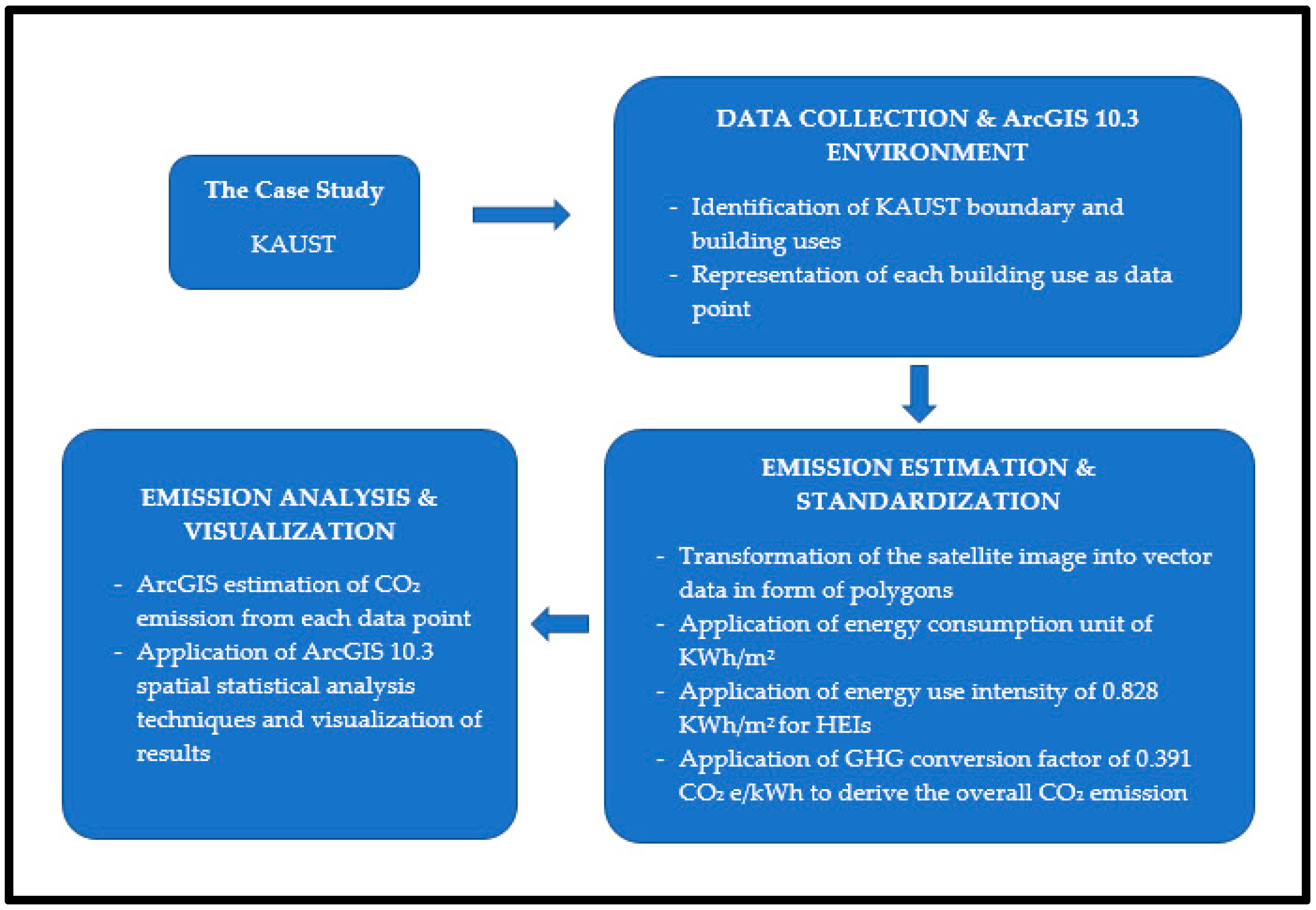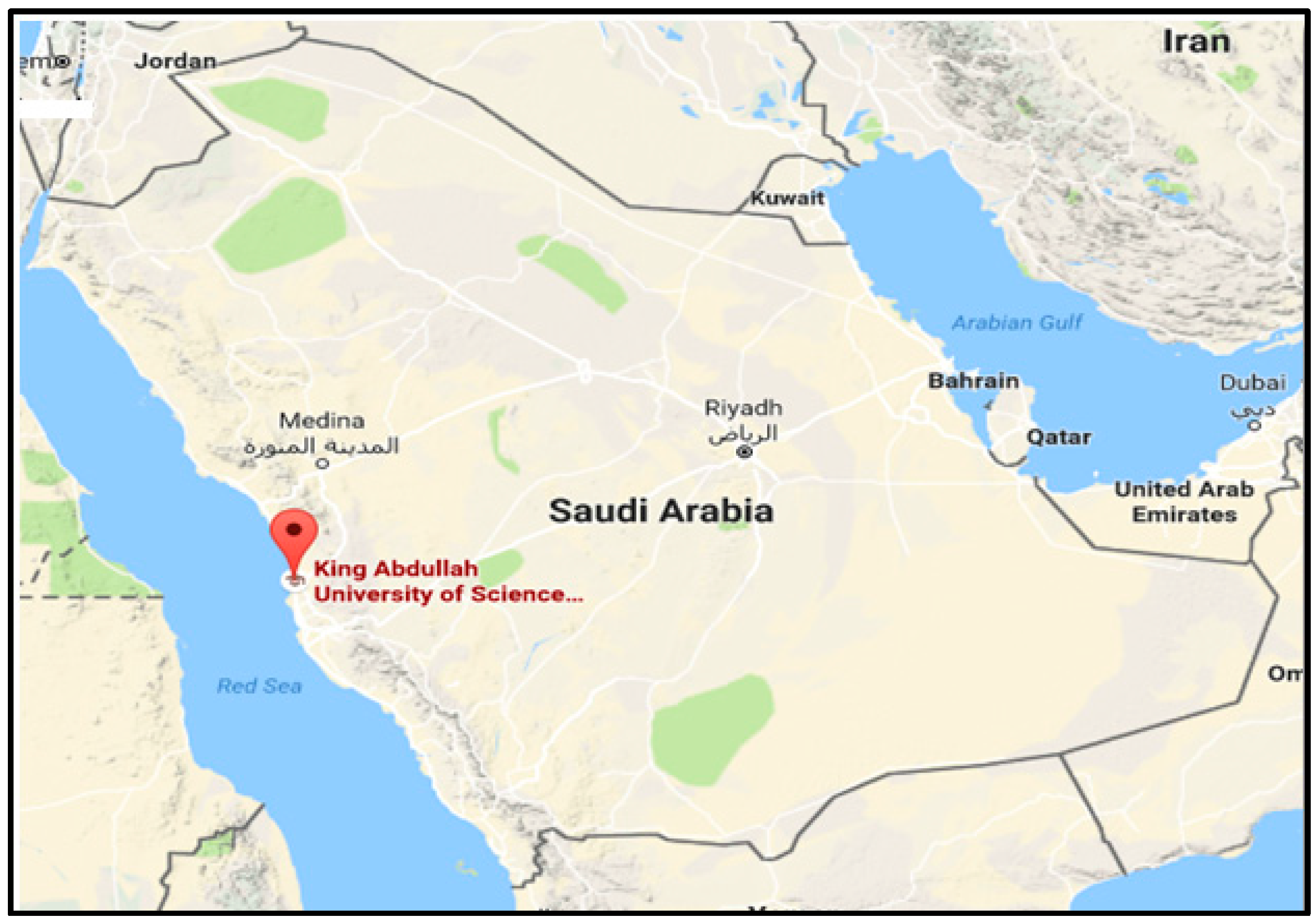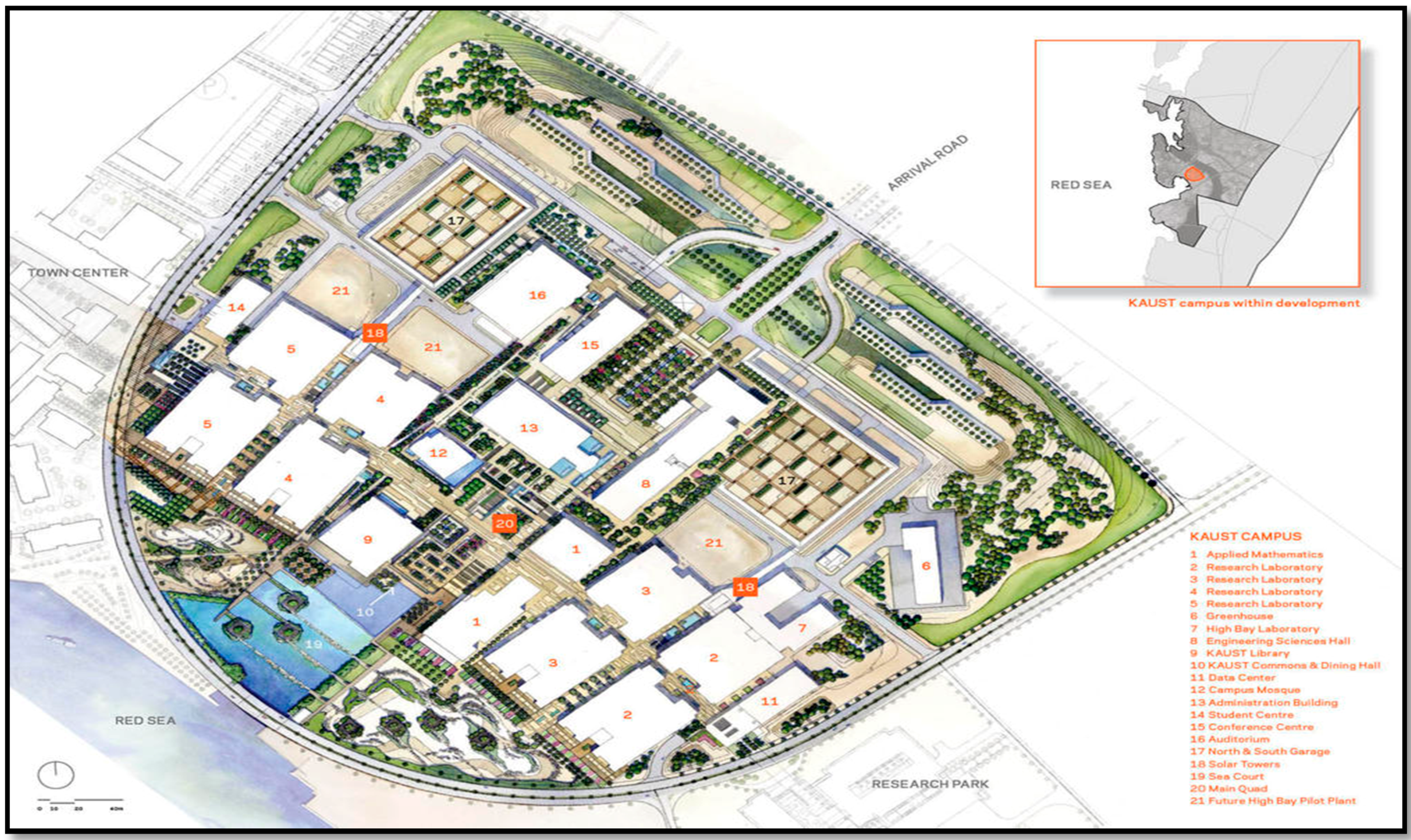Spatial Estimation and Visualization of CO2 Emissions for Campus Sustainability: The Case of King Abdullah University of Science and Technology (KAUST), Saudi Arabia
Abstract
:1. Introduction
2. Literature Review
2.1. CO2 Emissions and International Organizations Involvement
2.2. The 2030 Global Agenda for the Establishment of a Sustainable World
2.3. Towards a Sustainable Universities
2.4. Sustainability and Estimation of CO2 Emissions in Saudi Universities
3. Research Methodology
3.1. The Case Study—King Abdullah University of Science and Technology (KAUST)
3.2. Boundary and Land Use Identification of the University Campus
3.3. Data Collection for Emission Evaluation and Visualization
3.4. ArcGIS-Base Data Model
4. Results and Discussion
4.1. The Validation of the Spatial Estimation and Visualization of the CO2 Emission
4.2. Comparison with Other Saudi University
4.3. The Spatial Estimation and Evaluation of CO2 Emissions Model Limitations
5. Conclusions
Acknowledgments
Author Contributions
Conflicts of Interest
References
- Organization of the Petroleum Exporting Countries (OPEC). OPEC: Annual Statistical Bulletin. 2016, pp. 1–128. Available online: https://www.opec.org/opec_web/static_files_project/media/downloads/publications/ASB2016.pdf (accessed on 28 September 2017).
- Olabemiwo, F.A.; Danmaliki, G.I.; Oyehan, T.A.; Tawabini, B.S. Forecasting CO2 Emissions in the Persian Gulf States. Glob. J. Environ. Sci. Manag. 2017, 3, 1–10. [Google Scholar]
- Wiche, P.A. Water and Energy Consumption at King Abdullah University of Science and Technology. Master’s Thesis, King Abdullah University of Science and Technology, Thuwal, Saudi Arabia, 2012. [Google Scholar]
- Ahmed, A.H. Forecasting CO2 Emissions Lev Level in Saudi-Arabia (2014–2018) Using U Zeytun Time Series Statistical Software. Int. Res. J. Environ. Sci. 2016, 5, 27–36. [Google Scholar]
- United Nations (UN). Draft Outcome Document of the United Nations Summit for the Adoption of the Post—2015 Development Agenda. 2015. Available online: http://www.un.org/ga/search/view_doc.asp?symbol=A/69/L.85&Lang=E (accessed on 1 November 2016).
- Saudi Vision 2030. Available online: http://vision2030.gov.sa/en (accessed on 28 September 2017).
- Al-yami, A.M.; Price, A.D.F. An Overview of Sustainability in Saudi Arabia. In Proceedings of the CCIM 2006 Sustainable Development through Culture and Innovation, Dubai, UAE, 26–29 November 2006; pp. 109–119. [Google Scholar]
- Alshuwaikhat, H.M.; Adenle, Y.A.; Saghir, B. Sustainability Assessment of Higher Education Institutions in Saudi Arabia. Sustainability 2016, 8, 750. [Google Scholar] [CrossRef]
- Trencher, G.; Nagao, M.; Chen, C.; Ichiki, K.; Sadayoshi, T.; Kinai, M.; Kamitani, M.; Nakamura, S.; Yamauchi, A.; Yarime, M. Implementing Sustainability Co-Creation between Universities and Society: A Typology-Based Understanding. Sustainability 2017, 9, 594. [Google Scholar] [CrossRef]
- Grindsted, T.S. Sustainable Universities—From Declarations on Sustainability in Higher Education to National Law. Environ. Econ. 2011, 2, 29–36. [Google Scholar] [CrossRef]
- The Talloires Declaration. University Leaders for a Sustainable Future. 1990. Available online: http://www.ulsf.org/programs_talloires_td.html (accessed on 17 June 2016).
- Second Nature. 1993. Available online: http://www.secondnature.org (accessed on 17 June 2016).
- Wiedmann, T.; Minx, J. A Definition of ‘Carbon Footprint’. Science 2007, 1, 1–11. [Google Scholar]
- Intergovernmental Panel on Climate Change (IPCC). Mitigation of Climate Change. Contribution of Working Group III to the Fourth Assessment Report of the Intergovernmental Panel on Climate Change. 2007. Available online: http://www.ipcc.ch/pdf/assessment-report/ar4/wg3/ar4_wg3_full_report.pdf (accessed on 28 September 2017).
- Allen, C.; Metternicht, G.; Wiedmann, T. National Pathways to the Sustainable Development Goals (SDGs): A Comparative Review of Scenario Modelling Tools. Environ. Sci. Policy 2016, 66, 199–207. [Google Scholar] [CrossRef]
- Osborn, D.; Cutter, A.; Ullah, F. Universal Sustainable Development Goals: Understanding the Transformational Challenge for Developed Countries. Universal Sustainable Development Goals. 2015, pp. 1–24. Available online: https://sustainabledevelopment.un.org/content/documents/1684SF_-_SDG_Universality_Report_-_May_2015.pdf (accessed on 1 November 2016).
- Velazquez, L.; Munguia, N.; Platt, A.; Taddei, J. Sustainable University: What Can Be the Matter? J. Clean. Prod. 2006, 14, 810–819. [Google Scholar] [CrossRef]
- Cole, L. Assessing Sustainability on Canadian University Campuses: Development of a Campus Sustainability Assessment Framework. Master’s Thesis, Royal Roads University, Victoria, BC, Canada, 2003; pp. 1–66. [Google Scholar]
- Legacy, C. Campus Sustainability: Sustainability Assessment Framework at the University of Waterloo. Victoria 2004, 93. [Google Scholar]
- Alshuwaikhat, H.M.; Abubakar, I. An Integrated Approach to Achieving Campus Sustainability: Assessment of the Current Campus Environmental Management Practices. J. Clean. Prod. 2008, 16, 1777–1785. [Google Scholar] [CrossRef]
- Lukman, R.; Glavič, P. What Are the Key Elements of a Sustainable University? Clean Technol. Environ. Policy 2007, 9, 103–114. [Google Scholar] [CrossRef]
- Beringer, A.; Adomßent, M. Sustainable University Research and Development: Inspecting Sustainability in Higher Education Research. Environ. Educ. Res. 2008, 14, 607–623. [Google Scholar] [CrossRef]
- Association of University Leaders for a Sustainable Future. Welcome Page. Available online: http://ulsf.org/ (accessed on 24 September 2017).
- STARS. STARS Participants & Reports. Available online: https://stars.aashe.org/institutions/participants-and-reports/ (accessed on 24 September 2017).
- Association for Advancement of Sustainability in Higher Education. STARS Technical Manual; AASHE: Philadelphia, PA, USA, 2017. [Google Scholar]
- Riddell, W.; Bhatia, K.K.; Parisi, M.; Foote, J.; Imperatore, J. Assessing Carbon Dioxide Emissions from Energy Use at a University. Int. J. Sustain. High. Educ. 2009, 10, 266–278. [Google Scholar] [CrossRef]
- Lindstrom, T.; Middlecamp, C. Campus as a Living Laboratory for Sustainability: The Chemistry Connection. J. Chem. Educ. 2017, 94, 1036–1042. [Google Scholar] [CrossRef]
- Chinery, L. Measuring Your University’s Carbon Footprint: What Is a Carbon Footprint? 2008. Available online: http://thesa.utk.edu/docs/Carbon_footprintingL.pdf (accessed on 28 Septmeber 2017).
- Stevens, A.; Draucker, L. 2011 Greenhouse Gas Inventory and Sustainability Report. 2011. Available online: https://sustainability.utexas.edu/sites/sustainability.utexas.edu/files/2014GHGInventory.pdf (accessed on 28 September 2017).
- Robinson, O.J.; Tewkesbury, A.; Kemp, S.; Williams, I.D. Towards a Universal Carbon Footprint Standard: A Case Study of Carbon Management at Universities. J. Clean. Prod. 2017. [Google Scholar] [CrossRef]
- Townsend, J.; Barrett, J. Exploring the Applications of Carbon Footprinting towards Sustainability at a UK University: Reporting and Decision Making. J. Clean. Prod. 2015, 107, 164–176. [Google Scholar] [CrossRef]
- Gómez, N.; Cadarso, M.Á.; Monsalve, F. Carbon Footprint of a University in a Multiregional Model: The Case of the University of Castilla-La Mancha. J. Clean. Prod. 2016, 138, 119–130. [Google Scholar] [CrossRef]
- Larsen, H.N.; Pettersen, J.; Solli, C.; Hertwich, E.G. Investigating the Carbon Footprint of a University—The Case of NTNU. J. Clean. Prod. 2013, 48, 39–47. [Google Scholar] [CrossRef]
- Liu, H.; Wang, X.; Yang, J.; Zhou, X.; Liu, Y. The Ecological Footprint Evaluation of Low Carbon Campuses Based on Life Cycle Assessment: A Case Study of Tianjin, China. J. Clean. Prod. 2017, 144, 266–278. [Google Scholar] [CrossRef]
- Li, X.; Tan, H.; Rackes, A. Carbon Footprint Analysis of Student Behavior for a Sustainable University Campus in China. J. Clean. Prod. 2015, 106, 97–108. [Google Scholar] [CrossRef]
- Utaraskul, T. Carbon Footprint of Environmental Science Students in Suan Sunandha Rajabhat University, Thailand. Procedia Soc. Behav. Sci. 2015, 197, 1156–1160. [Google Scholar] [CrossRef]
- Aroonsrimorakot, S.; Yuwaree, C.; Arunlertaree, C.; Hutajareorn, R.; Buadit, T. Carbon Footprint of Faculty of Environment and Resource Studies, Mahidol University, Salaya Campus, Thailand. APCBEE Procedia 2013, 5, 175–180. [Google Scholar] [CrossRef]
- Letete, T.C.M.; Mungwe, N.W.; Guma, M.; Marquard, A. Carbon Footprint of the University of Cape Town. J. Energy S. Afr. 2011, 22, 2–12. [Google Scholar]
- Oludele, A.; Malasowe Bridget, O.; Onuiri Ernest, E. Greening the Campus: Design of a Generic Green IT Model for Possible Adoption. (A Case Study of an Educational Institution in Nigeria). Asian J. Comput. Sci. Inf. Technol. 2012, 2, 129–136. [Google Scholar]
- Ologun, O.O.; Wara, S.T. Carbon Footprint Evaluation and Reduction as a Climate Change Mitigation Tool—Case Study of Federal University of Agriculture Abeokuta, Ogun State, Nigeria. Int. J. Renew. Energy Res. 2014, 4, 176–181. [Google Scholar]
- Almufadi, F.A.; Irfan, M. Initial Estimate of Carbon Footprint of Qassim. Int. J. Appl. Eng. Res. 2016, 11, 8511–8514. [Google Scholar]
- Picoulet, J.; HOK. Schematic Diagram of KAUST. 2004. Available online: http://www.aiatopten.org/node/113 (accessed on 17 June 2016).
- Pérez-Lombard, L.; Ortiz, J.; Pout, C. A Review on Buildings Energy Consumption Information. Energy Build. 2008, 40, 394–398. [Google Scholar] [CrossRef]
- Site, U.M.; Data, U.R. Technical Reference U.S. Energy Use Intensity by Property Type. Energy Star Portfolio Manager, 2016; pp. 1–6. Available online: https://portfoliomanager.energystar.gov/pdf/reference/US%20National%20Median%20Table.pdf (accessed 1 November 2016).
- Vásquez, L.; Iriarte, A.; Almeida, M.; Villalobos, P. Evaluation of Greenhouse Gas Emissions and Proposals for Their Reduction at a University Campus in Chile. J. Clean. Prod. 2015, 108, 924–930. [Google Scholar] [CrossRef]
- Robinson, T.P.; Metternicht, G. Testing the Performance of Spatial Interpolation Techniques for Mapping Soil Properties. Comput. Electron. Agric. 2006, 50, 97–108. [Google Scholar] [CrossRef]
- Mondal, A.; Khare, D.; Kundu, S.; Mondal, S.; Mukherjee, S.; Mukhopadhyay, A. Spatial Soil Organic Carbon (SOC) Prediction by Regression Kriging Using Remote Sensing Data. Egypt. J. Remote Sens. Space Sci. 2017, 20, 61–70. [Google Scholar] [CrossRef]
- Desavathu, R.N.; Nadipena, A.R.; Peddada, J.R. Assessment of Soil Fertility Status in Paderu Mandal, Visakhapatnam District of Andhra Pradesh through Geospatial Techniques. Egypt. J. Remote Sens. Space Sci. 2017. [Google Scholar] [CrossRef]
- Tunçay, T.; Bayramin, İ.; Atalay, F.; Ünver, İ. Assessment of Inverse Distance Weighting (IDW) Interpolation on Spatial Variability of Selected Soil Properties in the Cukurova Plain. J. Agric. Sci. 2015, 22, 378–384. [Google Scholar]








| Building Use | CO2 Emission (kg) | CO2 Emission (tons) |
|---|---|---|
| Student Centre | 3924 | 3.9 |
| Research Laboratory | 17,906 | 17.9 |
| Research Laboratory | 17,906 | 17.9 |
| Commons and Dining Hall | 805 | 0.8 |
| Campus mosque | 529 | 0.5 |
| Admin and Eng. Science Hall | 20,966 | 20.9 |
| Conference Centre | 2661 | 2.6 |
| Auditorium | 7177 | 7.2 |
| Greenhouse | 652 | 0.7 |
| Greenhouse | 77 | 0.07 |
| High Bay Laboratory | 1162 | 1.2 |
| High Bay Laboratory | 1162 | 1.2 |
| Data Centre | 4204 | 4.2 |
| Research Laboratory | 17,906 | 17.9 |
| Research Laboratory | 17,906 | 17.9 |
| Applied Mathematics | 9412 | 9.4 |
| Solar Tower | 16 | 0.02 |
| KAUST Library | 3304 | 3.3 |
| Total CO2 emission | 127,675 | 127.7 |
| 2016 Student Population | 940 | |
| Net CO2 emission/Student/Year | 135.9 | 0.1 |
| Institutions | Total Carbon Footprint (kg CO2) | Net Carbon Footprint/Student/Year (kg CO2) |
|---|---|---|
| Qassim University [41] | 123,997,476 | 4360 |
| KAUST | 127,675 | 136 |
© 2017 by the authors. Licensee MDPI, Basel, Switzerland. This article is an open access article distributed under the terms and conditions of the Creative Commons Attribution (CC BY) license (http://creativecommons.org/licenses/by/4.0/).
Share and Cite
Adenle, Y.A.; Alshuwaikhat, H.M. Spatial Estimation and Visualization of CO2 Emissions for Campus Sustainability: The Case of King Abdullah University of Science and Technology (KAUST), Saudi Arabia. Sustainability 2017, 9, 2124. https://doi.org/10.3390/su9112124
Adenle YA, Alshuwaikhat HM. Spatial Estimation and Visualization of CO2 Emissions for Campus Sustainability: The Case of King Abdullah University of Science and Technology (KAUST), Saudi Arabia. Sustainability. 2017; 9(11):2124. https://doi.org/10.3390/su9112124
Chicago/Turabian StyleAdenle, Yusuf A., and Habib M. Alshuwaikhat. 2017. "Spatial Estimation and Visualization of CO2 Emissions for Campus Sustainability: The Case of King Abdullah University of Science and Technology (KAUST), Saudi Arabia" Sustainability 9, no. 11: 2124. https://doi.org/10.3390/su9112124





